
Jean-Auguste-Dominique Ingres was a French Neoclassical painter. Ingres was profoundly influenced by past artistic traditions and aspired to become the guardian of academic orthodoxy against the ascendant Romantic style. Although he considered himself a painter of history in the tradition of Nicolas Poussin and Jacques-Louis David, it is his portraits, both painted and drawn, that are recognized as his greatest legacy. His expressive distortions of form and space made him an important precursor of modern art, influencing Picasso, Matisse and other modernists.
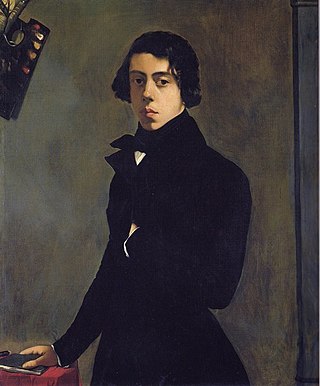
Théodore Chassériau was a Dominican-born French Romantic painter noted for his portraits, historical and religious paintings, allegorical murals, and Orientalist images inspired by his travels to Algeria. Early in his career he painted in a Neoclassical style close to that of his teacher Jean-Auguste-Dominique Ingres, but in his later works he was strongly influenced by the Romantic style of Eugène Delacroix. He was a prolific draftsman, and made a suite of prints to illustrate Shakespeare's Othello. The portrait he painted at the age of 15 of Prosper Marilhat, makes Théodore Chassériau the youngest painter exhibited at the Louvre museum.

Pierre-Nolasque Bergeret was a French painter, pioneer lithographer and designer of medals and costumes for the stage, who studied with Jacques-Louis David.

Madame Moitessier is a portrait of Marie-Clotilde-Inès Moitessier begun in 1844 and completed in 1856 by Jean-Auguste-Dominique Ingres. The portrait, which depicts Madame Moitessier seated, is now in the collection of the National Gallery in London, which acquired it in 1936.

The Apotheosis of Homer is a grand 1827 painting by Jean-Auguste-Dominique Ingres, now exhibited at the Louvre as INV 5417. The symmetrical composition depicts Homer being crowned by a winged figure personifying Victory or the Universe. Forty-four additional figures pay homage to the poet in a kind of classical confession of faith.

Odalisque with Slave is an 1839 painting by Jean-Auguste-Dominique Ingres commissioned by Charles Marcotte. Executed in oil on canvas, it depicts a nude odalisque, a musician, and a eunuch in a harem interior. The painting is in the Fogg Art Museum in Cambridge, Massachusetts. It is a classic piece of Orientalism in French painting.
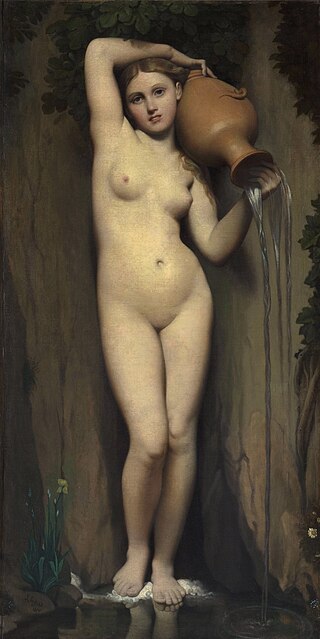
The Source is an oil painting on canvas by French neoclassical painter Jean-Auguste-Dominique Ingres. The work was begun in Florence around 1820 and not completed until 1856, in Paris. When Ingres completed The Source, he was seventy-six years old, already famous, and president of the École des Beaux-Arts. The pose of the nude may be compared with that of another by Ingres, the Venus Anadyomene (1848), and is a reimagination of the Aphrodite of Cnidus or Venus Pudica. Two of Ingres' students, painters Paul Balze and Alexandre Desgoffe, helped to create the background and water jar.
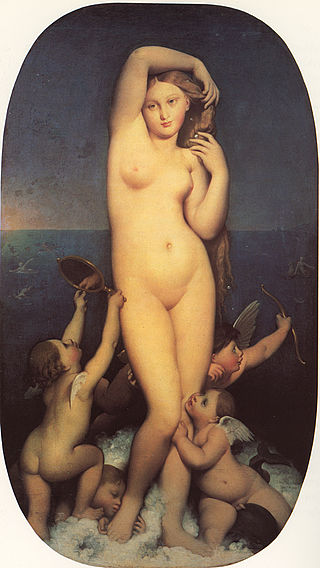
Venus Anadyomene is a painting by the French painter Jean-Auguste-Dominique Ingres. It is now held at the Musée Condé, Chantilly, France. It is a female nude of the Venus Anadyomene type, showing the goddess Venus rising from the sea.

Don Pedro of Toledo Kissing Henry IV's Sword was originally a painting of 1814 in the Troubador style by the French artist Jean-Auguste-Dominique Ingres, showing the Spanish ambassador Pedro Álvarez de Toledo, 5th Marquis of Villafranca kissing the sword of Henry IV of France in the salle des Caryatides of the Louvre Palace. The 1814 painting is now lost. Between 1819 and 1832, Ingres painted three additional versions of the subject.

Henry IV Receiving the Spanish Ambassador is an oil on canvas painting in the Troubador style by the French painter Jean-Auguste-Dominique Ingres, executed in 1817. It depicts Henry IV of France playing with his children whilst receiving the Spanish ambassador, with Marie de Medici seated at the centre.

The Sickness of Antiochus or Stratonice and Antiochus is an 1840 painting by the French artist Jean-Auguste-Dominique Ingres. It is now in the Musée Condé in Chantilly.
Raymond Balze was a French painter and art copyist.

The Martyrdom of Saint Symphorian is an 1834 painting by Jean-Auguste-Dominique Ingres. It shows the death of Saint Symphorian, the first Christian martyr in Gaul. Painted in oil on canvas and measuring 407 x 339 cm, it is now in Autun Cathedral. Although Ingres considered the painting—completed only after ten years of diligent work—one of his crowning achievements, it was criticized harshly when he exhibited it in the Paris Salon of 1834. It subsequently has been considered emblematic of Ingres' misguided ambition to excel as a history painter.
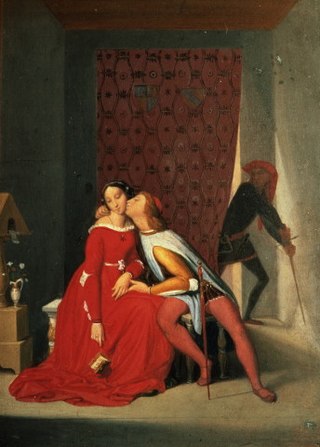
Paolo and Francesca is a painting by the French artist Jean-Auguste-Dominique Ingres, produced in seven known versions between 1814 and 1850. It derives from the story of Paolo and Francesca in Dante's Inferno. With Ingres' The Engagement of Raphael, these works represent early examples of the troubador style.

Roger Freeing Angelica or Ruggiero Freeing Angelica is an 1819 painting by Jean-Auguste-Dominique Ingres, inspired by Orlando Furioso by Ariosto. An oil painting on canvas measuring 147 x 199 cm, it is owned by the Louvre. Ingres subsequently painted several variants of the composition.
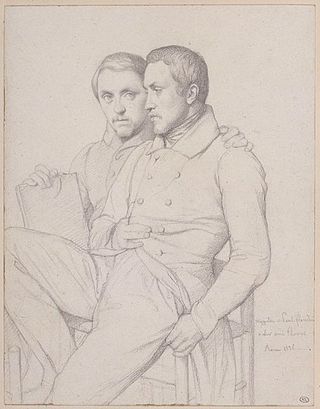
Paul Jean Flandrin was a French painter. He was the younger brother of the painters Auguste Flandrin and Jean-Hippolyte Flandrin.

Portrait of Madame Duvaucey is an 1807 oil on canvas painting by Jean-Auguste-Dominique Ingres. It shows Antonia Duvauçey of Nittis, the lover of Charles-Jean-Marie Alquier, then ambassador to the Holy See. Duvaucey is positioned in a flat pictorial space, gazing frontally at the viewer, dressed in lavish clothing and accessories. The portrait is the first female portrait painted during the artist's stay in Rome. Portrait of Madame Duvaucey is acclaimed for exhibiting her enigmatic charm, and as "not a portrait that gives pleasure..[but]...a portrait that gives rise to dreams".
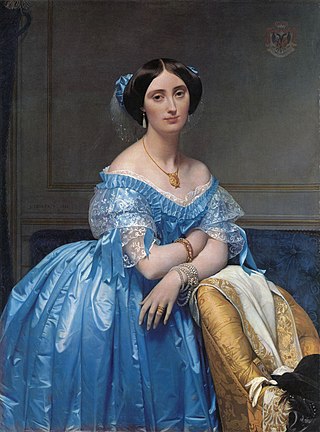
The Princesse de Broglie is an oil-on-canvas painting by the French Neoclassical artist Jean-Auguste-Dominique Ingres. It was painted between 1851 and 1853, and shows Pauline de Broglie, who adopted the courtesy title 'Princesse'. Born Pauline de Galard de Brassac de Béarn, she married Albert de Broglie, the future 28th Prime Minister of France, in 1845. Pauline was 28 at the time of the painting's completion. She was highly intelligent and widely known for her beauty, but she suffered from profound shyness and the painting captures her melancholia. Pauline contracted tuberculosis in her early 30s and died in 1860 aged 35. Although Albert lived until 1901, he was heartbroken and did not remarry.

The Portrait of Madame Jacques-Louis Leblanc is an oil painting by the French Neoclassical artist Jean-Auguste-Dominique Ingres, painted in 1823 and displayed at the Metropolitan Museum of Art in New York.

Virgil reading the Aeneid before Augustus, Livia and Octavia, known in French as Tu Marcellus Eris, is an 1812 painting by Jean-Auguste-Dominique Ingres. It is an oil on canvas measuring 304 x 323 cm and is in the Musée des Augustins in Toulouse. It depicts the moment when Virgil, reciting his work to the Emperor Augustus, his wife Livia and his sister Octavia, mentions the name of Octavia's dead son, Marcellus, causing Octavia to faint. Augustus' advisors, Marcus Agrippa and Gaius Maecenas, can be seen watching in the background. The painting is based on an anecdote, recorded in the late fourth-century vita of Virgil by Aelius Donatus, in which the poet read the passage in Book VI in praise of Octavia's late son Marcellus, and Octavia fainted with grief. This anecdote has also been depicted in works by other artists, including Jean-Joseph Taillasson, Antonio Zucchi, Jean-Baptiste Wicar, Jean-Bruno Gassies and Angelica Kaufmann.





















